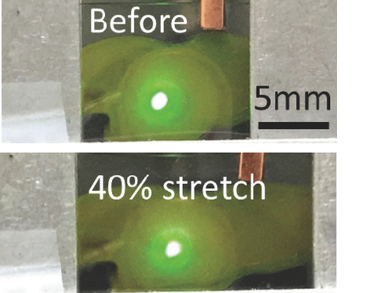Stretchable light emitting diodes (LEDs) are a key technology to enable wearable electronics and foldable displays. While it is possible to produce stretchable LEDs using luminescent polymers, these devices typically require high operating voltages and show limited brightness.
Zhibin Yu, Florida State University, Tallahassee, USA, Chuan Wang, Michigan State University, East Lansing, USA, and co-workers have developed a composite emitter that outperforms stretchable LEDs based on electroluminescent polymers only. In their device a film made of poly(ethylene oxide) (PEO) and methylammonium lead tribromide (MAPbBr3) served as the emissive layer. This emitter was combined with PEO-modified poly(3,4-ethylenedioxythiophene) polystyrene sulfonate (PEDOT:PSS) as the anode and eutectic indium-gallium as the cathode.
The result was an all-stretchable material with a turn-on voltage of 2.4 V and a maximum luminescence intensity of 15960 cd m–2. The films retained their luminescent properties over 100 cycles of stretching to 40 % of strain.
- Stretchable Light-Emitting Diodes with Organometal-Halide-Perovskite-Polymer Composite Emitters,
Sri Ganesh R. Bade, Xin Shan, Phong Tran Hoang, Junqiang Li, Thomas Geske, Le Cai, Qibing Pei, Chuan Wang, Zhibin Yu,
Adv. Mater. 2017.
DOI: 10.1002/adma.201607053



